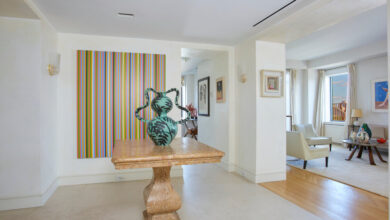How to Create a Guest Room That’s Comfortable, Even in a Pandemic

[ad_1]
When suitcase-toting friends and relatives arrive on your doorstep during the holidays, or at any other time of year, it’s good to have a welcoming place to put them, somewhat removed from the fray of everyday life.
“Traveling can be a stressful experience, so it’s nice to offer your guests a place to relax and recharge,” said Sean Anderson, an interior designer based in Memphis. “It’s about being mindful of who your guests are and how they live, so they’re calm and at peace when they’re staying in your home.”
That’s where a well-designed guest room — if you’re fortunate enough to have the space — can make a big difference.
Because guest rooms are used less frequently than other rooms, they can end up being a dumping ground for unwanted furniture or storage boxes. But when you’re expecting visitors, it’s time to clear out the clutter and add a few thoughtful touches.
As Mr. Anderson said, “It’s the details that really do make the difference.”
For help creating a guest room that visitors will never want to leave (be careful: it’s a blessing and a curse), we asked interior designers for advice.
Make a Statement or Stick With Neutrals
There are two schools of thought when it comes to designing a guest room. Because it’s a room that typically doesn’t get a lot of use, some designers recommend going all out with color and pattern, to make a big statement — similar to the way they treat powder rooms.
“For me, a guest bedroom is a place to have a little fun and maybe do something a bit unexpected,” said Heidi Caillier, a designer based in Seattle. “I find people are more open to a wallpaper or print, and making them interesting,” she added, “versus a primary bedroom, where they want it more relaxing.”
In a bedroom in one Connecticut house she designed, Ms. Caillier covered the walls in Fruit wallpaper from Morris & Co., which has a lively pattern of leaves, flowers, pomegranates, peaches and citrus fruit.
Other designers prefer to keep things simple. “I want it to have personality and style that ties into the aesthetic of the rest of the home, but not be so extreme or specific that some people love it and some people hate it,” said Mel Bean, a designer in Tulsa, Okla.
Ms. Bean suggested choosing colors and patterns that are likely to be universally appealing. “It should be a place everyone would want to sleep in,” she said. “That can lead to neutrals or it can lead to lots of color, but in a way that’s not too busy or stimulating.”
The choice is a personal one, and depends on the people you envision using the space — your fashionable friends, say, or your conservative grandparents — and what you want to communicate about your own sense of style.
Focus on the Basics
A guest room should not be a repository for lumpy old mattresses that would be better left at the curb. At the very least, it should provide the basics of a decent hotel room, said Roman Alonso, a principal of the Los Angeles-based design firm Commune. In other words: “a really comfortable mattress and high-end bedding,” as well as night stands, lamps for reading, and rugs if the room has hardwood, stone or ceramic floors.
Although storage might not be top of mind, every overnight guest will have luggage, so you’ll need to accommodate that, too. “I’m one of those people who, when I check into a hotel or stay as a guest in someone’s house, have to unpack everything,” Mr. Anderson said.
So in designing a guest room, he said, “I think about having somewhere to place luggage, be it on a rack or in a closet,” as well as providing a dresser, armoire or closet with hangers where people can properly store their things.
Pay Attention to Textiles
Even with inexpensive furniture, it’s possible to give a room a luxurious feeling using textiles. Start by focusing on the bed.
Fresh, clean sheets are essential. But on top of them, said Nicole Fisher, the founder of BNR Interiors in Hudson, N.Y., think about offering several different options for warmth: “Some people run hot, some people run cold, so you never know how they’re going to want to sleep.”
When Ms. Fisher prepares a guest room, she said, “there will always be a quilt, a duvet and a blanket,” so that people can adjust their layers.
Pillow preference is another unknown, so it’s helpful to provide multiple sleeping pillows with various levels of firmness — Ms. Caillier typically makes a bed with four — as well as throw pillows that can serve as back support for sitting up in bed.
Whether the bathroom is en suite or down the hall, Ms. Fisher said, it should be well stocked with fresh towels and washcloths. And if the bathroom is shared, guests should have designated towel bars, racks or hooks to keep their bath linens separate — especially with heightened concerns about germs in the midst of the pandemic.
Finally, make sure your guest room has appropriate window coverings. Rooms that get a lot of sunlight in the morning should have blackout shades or drapery, perhaps with a second layer of sheer curtains, so guests can control the light, Mr. Alonso said. In rooms that don’t get blasted by the sun, or by streetlights, an all-purpose light-filtering shade may suffice.
Add a Seating Area (and Maybe a Work Space)
Even the most sociable guests will eventually want a little time to themselves. To give them a place to go, try to include a seating area in the guest room, if there’s enough space.
It could be as simple as placing a single lounge chair, small side table and floor lamp in the corner of the room. “Oftentimes, I place those by a window, so you can just experience sitting in the sun,” Ms. Bean said. Other times, when space allows, she positions a small sofa at the foot of the bed.
Also consider whether there’s room to squeeze in a desk. “We’re definitely getting that request more now, since Covid,” Ms. Caillier said, as the pandemic has made remote work a possibility for many. “People want a work space, for their guests or for themselves, in that room.”
It doesn’t have to be big. A compact free-standing desk or even a wall-mounted one with a chair that tucks out of the way is usually enough space for working on a laptop.
Bring in the Accessories
Adding a few thoughtful touches can make a room feel extra special. Mr. Alonso and Ms. Bean like to have a coffee-and-tea station, as well as bottles of water, in guest rooms.
“I like to have a bar cart in the closet with an espresso machine and glass bottles of water,” Ms. Bean said. “You can even put a mini fridge in the closet, depending on the size.”
If you don’t have room for small appliances, place a carafe with a cup-shaped lid on the night stand, so guests won’t have to walk to the kitchen for a middle-of-the-night drink of water.
You should provide some reading material, as well, Ms. Bean said, including coffee-table books and magazines that reflect your interests: “That’s a way to share a little bit of your personality.”
For a decorative exclamation point, Ms. Fisher likes to add a vase of fresh flowers. For olfactory appeal, Mr. Anderson sometimes provides a scented candle and matches.
You might also consider providing the new constants of the pandemic — hand sanitizer and sanitizing wipes — tucked into the drawer of a night stand or in a basket. “These are not glamorous things,” Ms. Bean said, “but it’s something that can add a mental layer of safety and security.”
In the end, the goal is to make your guest’s visit feel “similar to staying in a luxury hotel,” Ms. Bean said, “where you’re thinking about and anticipating their needs.”
For weekly email updates on residential real estate news, sign up here. Follow us on Twitter: @nytrealestate.
[ad_2]
Source link






